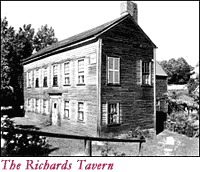Malden’s Road to Revolution Retraced, 2 May
The event description says: “Six costumed re-enactors will portray historic Maldonians in a script based on their lives written by historian Mary Fuhrer. Learn what was in the hearts and minds of residents as the Revolution approached.” Those personae include the Rev. Peter Thacher, enslaved worker Peter Green, and militia officer’s daughter Rebecca Dexter.
Fuhrer told me more about how this program grew out of collaboration with the Freedom’s Way Heritage Association:
Freedom’s Way has a program called Patriot’s Paths that helps towns research their local records to recover local stories in the decade leading up to April 19th. Once we’ve combed town meeting, church, court, probate, newspaper, letters, memoirs, etc. for evidence, we select six real local historical personae to tell the stories of the town’s path to revolution. We craft a 40-minute script with narrator and characters, showing how the road to revolution was uneven, contingent, influenced by personalities and localities, but ultimately driven by themes that are shared across the province.Sometimes communities don’t know their stories widely. Sometimes they do but think their stories are unique, not realizing how they parallel and connect to what other towns were doing at the same time. And in fact elements of every community’s story are unique, so research and comparison brings out those details.
The Malden Historical Society meeting is scheduled to start at 7:00 P.M. at the town’s public library, 26 Salem Street. It is free and open to the public. In addition to the presentation, there will also be an election of officers for the coming year. A reception will follow.
















